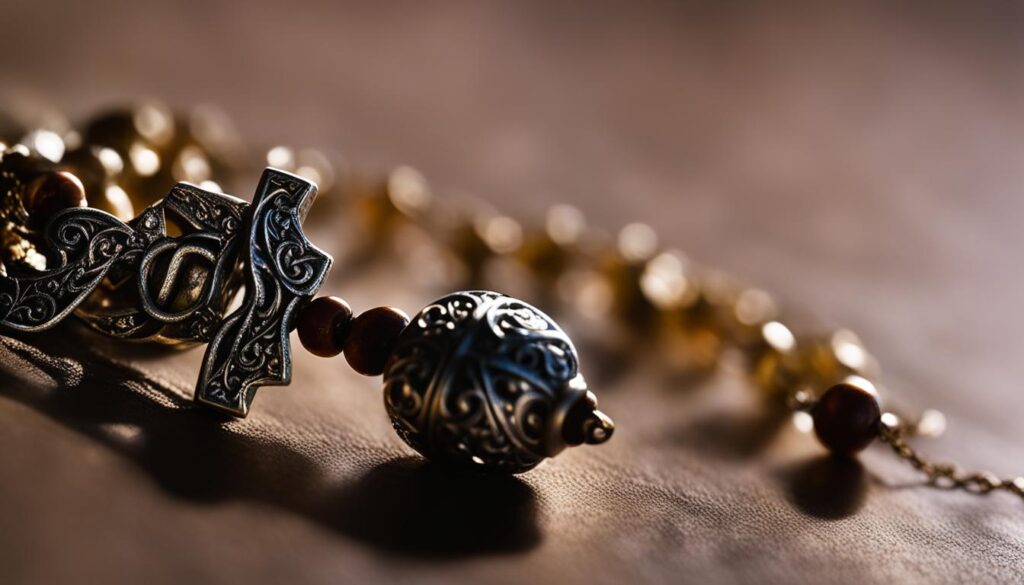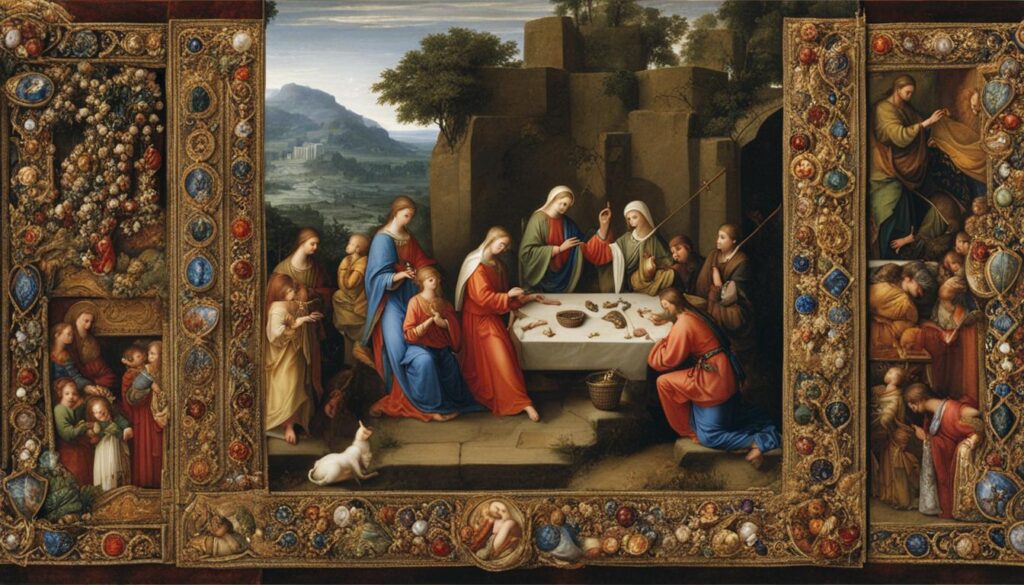Welcome to our comprehensive guide on how to pray the Rosary. The Rosary is a powerful devotional practice that allows us to reflect on the key events in the history of our salvation. It is a beautiful way to deepen our relationship with God and find inner peace and tranquility.
Praying the Rosary involves specific prayers and steps that guide us through the mysteries of the faith. By meditating on these mysteries and reciting the prayers, we can connect with the Gospel and experience spiritual growth.
In this article, we will explore the purpose of the Rosary and its mysteries, provide a step-by-step guide on how to pray the Rosary, discuss the significance of using Rosary beads, and highlight the power and benefits of this beautiful prayer practice. We will also delve into the historical and cultural significance of the Rosary and provide recommended prayers and variations for your spiritual journey.
Whether you are new to the practice or seeking to deepen your understanding, this guide will equip you with the knowledge and tools to master the art of praying the Rosary. Let’s embark on this sacred journey together.
Key Takeaways:
- The Rosary is a devotional practice that helps us reflect on key events in the history of our salvation.
- Praying the Rosary involves specific prayers and steps, including making the Sign of the Cross, reciting the Apostles’ Creed, Our Father, Hail Mary, and Glory Be, and meditating on the mysteries.
- Rosary beads are used to count prayers and maintain focus during prayer.
- Praying the Rosary has numerous benefits, such as bringing peace, tranquility, and spiritual connection, reducing stress and anxiety, and serving as a powerful form of intercession.
- The Rosary has a long historical and cultural significance, with roots in various religious traditions.
The Purpose of the Rosary and Its Mysteries
The Rosary serves a significant purpose in remembering the events of our salvation history and reflecting upon them. Central to the Rosary are the mysteries, which are based on the incidents in the life of Jesus and Mary celebrated in the Liturgy. Divided into four categories – Joyful, Luminous, Sorrowful, and Glorious – the twenty mysteries allow us to meditate on the entire liturgical cycle celebrated by the Church.
Changing the mysteries of the Rosary would result in the loss of the indulgences granted by the Church, emphasizing the importance of preserving the traditional structure. Each category of mysteries is associated with specific days of the week, enabling believers to journey through the life of Christ and Mary in a systematic manner.
To delve deeper into the mysteries, Catholics meditate on each one while reciting the Hail Mary prayer. This prayerful reflection fosters a deeper understanding of the Gospel and cultivates a personal connection to the divine. The Rosary serves as a powerful tool for spiritual growth as it enables individuals to engage with the profound mysteries of the faith.

Understanding the Different Rosary Mysteries
The Rosary encompasses a wide range of mysteries, offering believers a comprehensive understanding of the life of Christ and Mary. The Joyful Mysteries focus on events such as the Annunciation and the Nativity, highlighting the anticipation and joy surrounding the birth of Jesus. The Sorrowful Mysteries center on the Passion and Crucifixion, inviting reflection on the redemptive sacrifice of Christ. The Luminous Mysteries, instituted by Pope St. John Paul II, shed light on the public ministry of Jesus. Lastly, the Glorious Mysteries celebrate the Resurrection, Ascension, and the crowning of Mary as Queen of Heaven.
Each set of mysteries holds profound significance and allows believers to walk alongside Christ and Mary throughout their respective journeys. The Rosary provides a structured and contemplative prayer practice that deepens one’s faith and imparts a sense of peace and spiritual connectedness.
How to Pray the Rosary
Praying the Rosary is a sacred and time-honored tradition in the Catholic faith. It is a beautiful way to deepen one’s connection with God and to reflect on the mysteries of the faith. Here is a step-by-step guide on how to pray the Rosary:
- Making the Sign of the Cross: Begin by making the Sign of the Cross, saying the words, “In the name of the Father, and of the Son, and of the Holy Spirit. Amen.”
- Reciting the Apostles’ Creed: After the Sign of the Cross, recite the Apostles’ Creed, affirming your belief in the core teachings of the Catholic Church.
- Saying the Our Father, Hail Mary, and Glory Be: Proceed to say the Our Father, followed by ten Hail Marys, and the Glory Be, after which you can add the optional Fatima prayer.
- Meditating on the mysteries: The Rosary is divided into four sets of mysteries: Joyful, Luminous, Sorrowful, and Glorious. For each decade, announce the specific mystery and contemplate its significance while reciting one Our Father and ten Hail Marys.
- Concluding the Rosary: After completing all five decades, conclude the Rosary by reciting the Hail Holy Queen and a final prayer.
Throughout the entire Rosary, it is customary to hold rosary beads in your hands. These beads serve as a guide, helping you keep track of the prayers and providing a tactile reminder of your devotion.

Quote: “The Rosary is the ‘weapon’ for these times.” – Saint Padre Pio
Additional Variations and Modes of Praying the Rosary
While the traditional form of praying the Rosary is widely practiced, there are also other variations and modes for those seeking different approaches to this prayer. One such variation is the Scripturally Based Rosary, which incorporates relevant Bible passages between the prayers to provide a deeper context for meditation. Another variation is the Rosary in Stained Glass, where each mystery is represented by a beautiful stained glass image, creating a visual aid for contemplation.
These variations allow individuals to customize their Rosary experience according to their personal preferences and spiritual practices. Whether you choose the traditional Rosary or one of the variations, the important thing is to engage in sincere prayer and reflection, seeking a closer connection with God through the intercession of the Blessed Virgin Mary.
Praying the Rosary with Rosary Beads
Using rosary beads is a common practice among Catholics when praying the Rosary. These beads serve as a physical aid in keeping track of the prayers recited. Each bead represents a specific prayer, allowing the individual to maintain focus and concentration during the prayer. Praying the Rosary with rosary beads can be particularly helpful for beginners or those who prefer a tangible representation of their prayers.
When using rosary beads, the individual holds the crucifix and begins by making the Sign of the Cross. They then move their fingers along the beads, reciting the designated prayers for each bead. The beads provide a systematic way to navigate through the prayer, ensuring that all prayers are properly completed. This practice can be especially valuable in situations where distractions may arise, as it helps to anchor one’s thoughts and intentions.
Praying the Rosary with rosary beads is not only a practical tool but also a meaningful ritual. The physical act of moving along the beads can create a sense of rhythm and continuity, facilitating a deeper connection with the prayers being said. It allows individuals to engage both their minds and bodies in the act of prayer, enhancing the spiritual experience.

Table: Steps for Praying the Rosary with Rosary Beads
| Step | Description |
|---|---|
| 1 | Hold the crucifix and make the Sign of the Cross. |
| 2 | Move your fingers to the first bead and recite the Apostles’ Creed. |
| 3 | Proceed to the next bead and recite the Our Father prayer. |
| 4 | Continue with the following three beads, reciting the Hail Mary prayer on each bead. |
| 5 | Conclude the set of beads with the Glory Be prayer. |
| 6 | Announce the mystery and recite the Our Father prayer. |
| 7 | Recite ten Hail Mary prayers, one for each bead, while meditating on the mystery. |
| 8 | Conclude the decade with the Glory Be and the optional Fatima prayer. |
| 9 | Repeat steps 6-8 for each of the remaining four decades. |
| 10 | Conclude the Rosary with the Hail Holy Queen and the Final Prayer. |
The Power and Benefits of Praying the Rosary
Praying the Rosary offers numerous benefits and holds a profound spiritual power. Through this devotional practice, individuals can find peace, tranquility, and a deep connection with God. The repetitive nature of the prayers can have a calming effect, helping to reduce stress and anxiety. By meditating on the mysteries of the faith while reciting the prayers, the Rosary allows for a profound spiritual experience that strengthens one’s relationship with God.
Additionally, the Rosary serves as a powerful form of intercession. It provides a means to pray for specific intentions and requests, whether personal or for the greater good of the world. The act of praying the Rosary with sincerity and devotion can bring about transformative change and inspire a more peaceful and harmonious world. Many individuals find solace and comfort in the rhythm and structure of the Rosary, experiencing a sense of spiritual renewal and a deep connection with the divine.
Furthermore, the Rosary is a gateway to deep meditation. Each mystery of the Rosary offers an opportunity to reflect on different aspects of the life of Jesus and Mary. This meditative practice allows for a deeper understanding of the mysteries of the faith and fosters spiritual growth. The Rosary invites individuals to contemplate the love, sacrifice, and teachings of Jesus, providing a pathway to personal transformation and a closer union with God.
| Benefits of Praying the Rosary |
|---|
| The Rosary brings peace and tranquility. |
| It reduces stress and anxiety. |
| The Rosary strengthens the relationship with God. |
| It serves as a powerful form of intercession. |
| The Rosary deepens meditation and spiritual growth. |
The Rosary and its Historical Significance
Before Christianity, various religious traditions used prayer beads as a tool for counting prayers. In the 13th century, Mary appeared to St. Dominic de Guzman and gave him the Rosary, which replaced the practice of praying the Psalms on beads or knots. The original Dominican Rosary consisted of fifteen decades, but it was later abbreviated to the five-decade Rosary that is most commonly used today. The Rosary has a long history and has been a significant devotional practice for Catholics for centuries.

The Rosary holds deep historical significance as a traditional prayer tool. It has evolved over time and encompasses the rich heritage of devotion and spirituality. The incarnation of the Rosary is attributed to St. Dominic, who popularized the practice in the 13th century. However, the use of prayer beads predates Christianity and has roots in various cultures and religions.
The origins of the Rosary can be traced back to the early monks, who used pebbles or knots to count their prayers. This practice evolved into the use of beads and became an integral part of Catholic spirituality. The Rosary emerged as a powerful tool for meditation, allowing believers to engage in deep reflection on the life and teachings of Jesus and Mary.
Today, the Rosary continues to be cherished by Catholics around the world as a means of seeking spiritual connection and finding solace in prayer. Its historical significance highlights the enduring power of devotion and the universal human quest for spiritual enlightenment.
Recommended Prayers and Variations for the Rosary
Praying the Rosary offers a variety of prayers and variations that can enhance the spiritual experience and allow for personalization. These prayers and variations provide different approaches to the traditional Rosary, catering to individual preferences and spiritual practices. Additionally, they offer creative ways to deepen one’s connection with God and engage in meaningful contemplation.
Recommended Prayers:
- The Divine Mercy Chaplet: This prayer, inspired by the revelations of Jesus to St. Faustina Kowalska, focuses on the mercy of Jesus. It is shorter than the Rosary and consists of specific prayers that call upon the mercy of God for oneself and the whole world.
Variations:
The Rosary offers various modes and variations that can be incorporated into one’s prayer routine. These variations provide different ways of meditating on the mysteries, adding depth and richness to the experience. Some notable variations to explore include:
- Scripturally Based Rosary: This variation incorporates biblical passages related to each mystery. It allows for a deeper engagement with the Word of God and provides a more comprehensive understanding of the mysteries.
- Rosary in Stained Glass: This visual variation includes images of stained glass artwork depicting the mysteries. It offers a visually stimulating experience, enhancing the meditative aspect of the Rosary.
Exploring these recommended prayers and variations can add new dimensions to the practice of praying the Rosary. They invite individuals to engage with the mysteries in unique ways, fostering a deeper connection with God and a richer understanding of the faith.

Praying the Rosary for Peace
The Rosary has long been recognized as a powerful prayer for peace. It is a spiritual practice that allows individuals to come together and seek harmony in the world. The act of praying the Rosary itself is a powerful act of intercession, as it calls upon the intercession of Mary, the Mother of Peace, to bring about peace and understanding among all nations.
Popes John Paul II, Paul VI, and John XXIII have all emphasized the importance of praying the Rosary for peace in the world. They have encouraged the faithful to use the Rosary as a means of entreaty to ask God for peace and to sow seeds of love and understanding. The Rosary serves as a reminder of the importance of peace, both in our individual lives and in the world as a whole.
Praying the Rosary for peace can have a profound impact on individuals and communities. It allows us to reflect on the teachings of Jesus and Mary, and to ask for their guidance and intercession in bringing about peace. By praying the Rosary, we are not only seeking peace for ourselves but also for all those who are affected by conflict and unrest. It is a powerful way to join our prayers with the prayers of millions around the world who are also seeking peace.
Prayers for Peace
There are several prayers that can be incorporated into the Rosary when praying for peace. These prayers express our desire for peace and call upon God and the intercession of Mary to bring about harmony and reconciliation. Some of these prayers include:
- The Prayer of St. Francis: “Lord, make me an instrument of your peace…”
- The Prayer of St. Teresa of Avila: “Let nothing disturb you, let nothing frighten you…”
- The Prayer of St. Pope John Paul II: “O Mary, Queen of Peace, pray for us…”
These prayers, along with the traditional prayers of the Rosary, help to create a powerful spiritual experience focused on peace. They remind us of the importance of our role in working towards peace and serve as a source of hope and inspiration.
| Benefits of Praying the Rosary for Peace | How to Pray the Rosary for Peace |
|---|---|
| – Brings a sense of peace and tranquility | – Begin by making the Sign of the Cross |
| – Deepens our relationship with God | – Recite the Apostles’ Creed and the Our Father |
| – Fosters a spirit of intercession | – Meditate on the mysteries while saying the Hail Mary |
| – Provides an opportunity for reflection and meditation | – Conclude with the Hail Holy Queen |
“Praying the Rosary for peace is a powerful act of intercession and can contribute to the building of a more peaceful and harmonious world.” – Pope John Paul II
Rosary Prayers for World Peace
Praying the Rosary for world peace is a deeply meaningful practice that has been embraced by countless individuals throughout history. This powerful act of intercession allows believers to offer their prayers to Mary, the Mother of Peace, and seek her intercession in bringing about harmony and tranquility in the world. As Pope John Paul II once said, “The Rosary is a privileged means of contemplating Jesus and experiencing His mercy. By praying it, we can participate in the healing and reconciling mission of Christ.”
When praying the Rosary for world peace, there are specific prayers that can be incorporated into the traditional Rosary prayers. These prayers express the universal desire for peace and unity among nations and invoke the intercession of Mary, who is revered as the Queen of Peace. One such prayer is the Prayer of Pope John Paul II for Peace, which reads:
“O Mary, Queen of Peace,
at all times and in every age,
and lead them along the path of peace.
Reveal your Son to those who do not know Him,
so that they may accept Him and find peace in Him.
Mary, Mother of Mercy, pray for us,
that peace may reign in our hearts,
our nations, and the whole world.”
In addition to these prayers, the act of praying the Rosary itself is a powerful tool for promoting peace. By meditating on the mysteries of the Rosary, individuals can reflect on the life, teachings, and example of Jesus, who is the ultimate source of peace. This deep reflection and contemplation can inspire individuals to strive for peace in their own lives and contribute to peacebuilding efforts in their communities and beyond.
Ultimately, praying the Rosary for world peace is an act of faith and hope. It is a way for believers to align themselves with God’s plan for harmony and unity and entrust their prayers for peace to the intercession of Mary. As they lift their hearts and voices in prayer, they join a global community of individuals who are united in their desire for a more peaceful and compassionate world.
The Historical and Cultural Significance of Rosary Beads
Rosary beads have a rich historical and cultural significance that spans across different religious traditions. Before Christianity, prayer beads were used by various faiths as tools for counting prayers and aiding in devotional practices. The use of beads in prayer has been found in religions such as Hinduism, Buddhism, Taoism, and Islam.
In the Catholic tradition, rosary beads serve as a tangible reminder of the prayers being said and provide a way to keep track of the prayers. The beads are used as a physical aid to guide the faithful in the recitation of prayers, such as the Our Father and the Hail Mary. The repetition of these prayers, combined with the tactile experience of moving the beads, helps to create a meditative and contemplative atmosphere.
The cultural significance of rosary beads lies in their universality and symbolism. They represent a universal human impulse to seek prayerful connection and spiritual solace. Through the use of beads, individuals can engage in a deeply personal and introspective prayer practice, regardless of their cultural or religious background.
Table: Comparison of the Use of Beads in Different Religions
| Religion | Use of Beads |
|---|---|
| Hinduism | Beads are used in the form of a mala to count repetitions of mantras and prayers. |
| Buddhism | Beads, often in the form of a mala, are used to count the recitation of mantras and prayers during meditation. |
| Taoism | Beads, known as yuanyuan, are used for praying and seeking blessings from deities. |
| Islam | Tasbih, a string of beads, is used for reciting the 99 names of Allah and counting prayers. |
| Catholicism | Rosary beads are used to recite prayers, meditate on the mysteries of the faith, and seek spiritual connection. |
“The use of beads in prayer is a common thread that runs through various religious and cultural traditions. It highlights our innate desire to connect with the divine and find solace in prayer. Whether it is the rosary beads of Catholicism or the mala beads of Hinduism and Buddhism, these tangible objects serve as physical reminders of our devotion and create a sense of rhythm and focus in our prayers.”
Conclusion
Praying the Rosary is a deeply meaningful spiritual practice with abundant benefits. It fosters a deeper connection with God, instills a profound sense of peace and tranquility, and allows for contemplation of the mysteries of the faith. By engaging in the Rosary, individuals can personalize their prayer experience through various modes and variations, catering to their unique spiritual preferences.
The historical significance of the Rosary as a prayer tool cannot be overlooked. It has served as a powerful means of seeking peace and harmony in the world throughout centuries. Popes have encouraged the faithful to use the Rosary as a tool for intercession, with the aim of promoting love, understanding, and unity among all nations.
Regardless of one’s religious background, the Rosary offers a potent medium for prayer and spiritual connection. Its universal appeal transcends cultural boundaries, resonating with the common human desire for prayerful solace and connection. Embracing the Rosary can bring transformative benefits to individuals, communities, and the world at large.
FAQ
What is the purpose of the Rosary and what are its mysteries?
The purpose of the Rosary is to help keep in memory certain principal events in the history of our salvation. The Rosary includes twenty mysteries divided into the five Joyful, Luminous, Sorrowful, and Glorious Mysteries.
How do I pray the Rosary?
Praying the Rosary involves specific steps and prayers. These include making the Sign of the Cross, reciting the Apostles’ Creed, praying the Our Father, Hail Mary, and Glory Be, and meditating on the mysteries while saying the Hail Mary.
How can I use Rosary beads during prayer?
Rosary beads are used to help Catholics count their prayers during the Rosary. Each bead represents a prayer, providing a tangible way to keep track of the prayers and maintain focus and concentration during the prayer.
What are the benefits of praying the Rosary?
Praying the Rosary can bring a sense of peace, tranquility, and spiritual connection. It allows for deep meditation on the mysteries of the faith, helps to strengthen one’s relationship with God, and can have a calming effect, reducing stress and anxiety.
What is the historical significance of the Rosary?
The Rosary has a long history and has been a significant devotional practice for Catholics for centuries. It replaced the practice of praying the Psalms on beads or knots and has been a traditional prayer for seeking peace and harmony.
Are there variations or recommended prayers for the Rosary?
Yes, there are several recommended prayers and variations for praying the Rosary, including the Divine Mercy Chaplet and different modes of praying the Rosary such as the Scripturally Based Rosary and the Rosary in Stained Glass.
Can I pray the Rosary for peace?
Absolutely! Praying the Rosary for peace is encouraged by the Church as a means of seeking harmony and reconciliation in the world.
Are there specific prayers for praying the Rosary for world peace?
Yes, various prayers have been composed specifically for praying the Rosary for world peace by Popes John Paul II, Paul VI, and John XXIII. These prayers emphasize the desire for peace among all nations and call upon Mary to intercede for peace.
What is the historical and cultural significance of rosary beads?
Rosary beads have a rich historical and cultural significance. They have been used by different religions as aids in their devotional practices and symbolize the universal human impulse to seek prayerful connection and spiritual solace.
What are the benefits of praying the Rosary?
Praying the Rosary has numerous benefits, including deepening one’s relationship with God, bringing peace and tranquility, and allowing for meditation on the mysteries of the faith. It is a powerful tool for prayer and spiritual connection.








